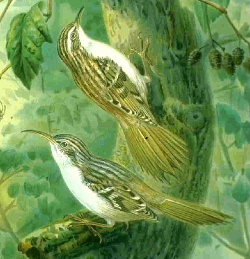Treecreeper
| Treecreeper | ||||||||||||
|---|---|---|---|---|---|---|---|---|---|---|---|---|

Treecreeper ( Certhia familiaris ) |
||||||||||||
| Systematics | ||||||||||||
|
||||||||||||
| Scientific name | ||||||||||||
| Certhia familiaris | ||||||||||||
| Linnaeus , 1758 |
The Waldbaumläufer ( Certhia familiaris ) is a bird art of the genus of authentics treecreepers ( Xuanmu ) from the family of the creeper (Certhiidae).
description
The treecreeper is one of the smallest birds in Europe and grows to 12 to 13 cm. The weight is 9 g. In terms of appearance, it can hardly be distinguished from the treecreeper , but its rear toe claw is longer than this one. In addition, the treecreeper generally has a shorter beak, a purer white underside and eye stripe, and a whiter, more contrasting spot on its mantle. A reliable distinction can be made by voice.
Its pointed beak is curved downwards and becomes 12 to 14 mm long. He uses the tail feathers up to 5 cm long to support and steer. The underside of the body is white, the upper side is bark-colored and the outer eye stripe is white. Males and females have the same coloration. His call sounds something like "siih" or "tih". The short vocal stanza is a descending series of soft whistling tones that rise again towards the end and is reminiscent of the vocalizations of the blue tit and Fitis . Treecreeper can live up to seven years.
Habitat and Distribution
The treecreeper inhabits coniferous and mixed forests in Europe all year round (except for the Iberian Peninsula south of the Pyrenees), preferably in denser areas. In Asia, its distribution area extends from the Urals through southern Siberia to Japan and northern China. The European population is estimated at 5.7 to 11 million breeding pairs (25–50% of the world population).
nutrition
The treecreeper mainly eats insects and spiders . To search for food, it climbs jerkily and helically up trunks and thick branches and pokes into cracks in and behind the bark with its beak .
Reproduction

The sexual maturity occurs after one year. The breeding season extends from March to July. The nest is built from rice , moss , animal hair and feathers in tree crevices and behind loose bark. The female lays five to eight eggs and then warms them for two weeks until the young birds hatch. After 14 to 15 days, the young leave the nest and are looked after by the adults for a longer period of time.
voice
The treecreeper calls out "srri" (more delicate and inconspicuous than a similar blackbird call) repeatedly, finely, jingling trillingly, sometimes loosely, repeatedly, thinly and cleanly (without "r") "tiih". The singing is a 2-3 second high verse (with a sound like a blue tit), sloping with curlicues or trills at the end.
Web links
- Certhia familiaris in the endangered Red List species the IUCN 2015 Posted by: BirdLife International, 2012. Retrieved on February 2, 2016th
- Videos, photos and sound recordings of Certhia familiaris in the Internet Bird Collection
- Swiss Ornithological Institute in Sempach: Treecreeper
- Treecreeper feathers
- Video: Certhia familiaris (Certhiidae) - raising the young in the nest . Institute for Scientific Film (IWF) 1967, made available by the Technical Information Library (TIB), doi : 10.3203 / IWF / E-1052 .
- xeno-canto: Sound recordings - Treecreeper ( Certhia familiaris )
Individual evidence
- ↑ a b c Lars Svensson, 1941-, KLillian Mullarney, 1958-, Dan Zetterström: Der Kosmos Vogelführer: all kinds of Europe, North Africa and the Middle East . 2nd updated edition 2018 edition. Stuttgart, ISBN 978-3-440-15635-3 .
- ↑ BirdLife International (2015) Species factsheet: Certhia familiaris . Retrieved March 11, 2015.

